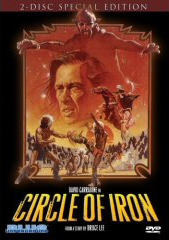
An uneven if visually stunning attempt at combining Zen philosophy, martial arts, and gonzo action with archetypically charged magic landscapes of fantasy and sweat, Circle of Iron is one of those rare and unfortunate films that are just as notable for what it fails to do as what it achieved. Based loosely on a screenplay by Bruce Lee, what could have been a philosophically rich blitzkrieg of Zen mysticism, bloody wisdom, and visual beauty instead trips across its own excess of scattered ideas, inferior acting, and undisciplined story structure. Filmed as a posthumous homage to Lee's memory and original idea after his death, too much of Lee's original scope and character depth (if not ego) was lost in translation. The result is a maddening if absurdly enjoyable orgy of disassociated sights and sounds technologically enlivened by Blue Underground's usual attention to quality and extra materials.
In a mysterious land of spirit and mind, body and intent, a martial arts contest is used to decide which man will be granted the sacred quest of retrieving the Book of All Knowledge from the evil and dangerous wizard Zetan (Christopher Lee) . The combatants come from all corners of the world and from various styles and schools. A frenzied and seemingly undisciplined outsider called Cord the Seeker (Jeff Cooper, Dallas) disrupts the proceedings and offends both teachers and pupils with his rude manners and unorthodox manner of fighting. Though he fights well enough, he is soon disqualified, and his request to be the school's champion is denied. After the chosen champion fails, Cord takes the sacred medallion that embodies the trial, and embarks upon his perilous journey. Along the way, in typical Epic Quest fashion, he finds a mentor in the enigmatic blind man/teacher (David Carradine, Kill Bill: Volume 2, Kung Fu), who instils Zen wisdom to Cord, thereby aiding him in various struggles with the dangers left by the wizard.
Resembling the mystical-cum-karate-chop tone of the legendary series Kung Fu, Circle of Iron combines introspective journeys inward with the mirroring spectacle of physical trials and conflict. This is admirable, and if the writing were better structured, events tightened up, and characters more assessable, the film might have became something of a minor legend in action cinema. As it is, the story entertains on a primal gut level while sense is tossed out the window. More importantly, and structurally significant, is the film's uneven yet fascinating attempts to hang its plot on the archetypical plot patterns and themes of classic mythology, particularly those of Epic Quest Literature. We have here the coming of age, invitation to adventure, initiation, and the aid of a more experienced (Merlin-like) figure. In addition, each conflict brings further wisdom, and the key to physical triumph is closely connected to first surviving/facing internal struggles. Unlike such Epic Myths, Circle of Iron lacks dramatic focus, dooming it to be more of a curiosity than a successful story. Originally entitled The Silent Flute by Lee, who worked on the script with actor James Coburn, personality conflicts led to the project's abandonment. What we see here is a re-written effort, with the mysticism toned down for spiritually dead western audiences, and a plot that gets lost in itself. Still, if the film is an interesting failure, than its underlying ideas and imagery are both complex and beautiful. The settings are lush and fantastical, and the relation established between physical locations and internal conflict intriguing. A rabid sense of style underlies the entire project. Unfortunately neither the style or tone is enough to completely make up for such a lack of clear plot development. Perhaps, though, this is what makes the film of interest. It could be suggested (though it is stretching things a bit) that the disorientation of action and plot are also mirrors of the character's internal instability and struggles . . . Or you could simply enjoy the film as the crazed and well meaning orgy of color, action, and fantasy that it is.
If the quality and tone of Circle of Iron is faulty, the technical presentation and quality of supplements are anything but. A technical triumph of visual and audio quality, the DVD is featured re-mastered, largely eliminating any print damage. Besides occasional grain, visual integrity is great, including bold colors, sharp blacks, and vivid detail that lends authenticity to the fantastic themes and locations. Audio is just as impressive, including Dolby Digital 5.1 Surround and DTS-ES 6.1 Surround Sound. Both mirror the fierceness and spectacle of the movie, featuring admirable attention to detail and satisfying attention to both sound effects and score. Additional audio options are a bare bones Dolby 2.0 Surround track and mono tracks in both original language and French dubbed. Extras are vivid and informative, perhaps better than the feature itself. These include a "Commentary" with director Richard Moore, who reviews the film and his career in unassuming and honest fashion.
This first disc also features "TV spots" that are fun eye candy and as cheesy as you might expect. The second disc features the bulk of the supplements, including THREE futurities, including interviews with David Carradine, co-producer Paul Maslansky, and martial artsman Joe Lewis. These are all exceptional in the amount of detail and depth covered, covering the initial themes, development, and filming of the production. Discussing not only their own particular roles and positions, each subject is also quick to expound on the overall challenges of the feature. Next up is an "Audio Interview" with co-writer Stirling Silliphant, which is intriguing despite the poor audio quality, followed by a "Textual Essay" of the film, "Poster Galleries," and a first draft of The Silent Flute, by Bruce Lee. A wonderfully vivid and rich package for a confused if exciting genre experience.
Review by William Simmons
| Released by Blue Underground |
| Region 1 - NTSC |
| Not Rated |
| Extras : |
| see main review |